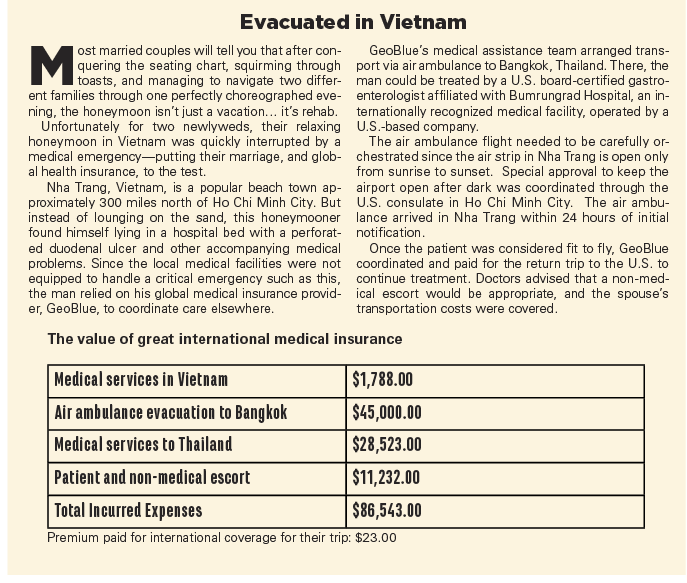
By Todd Taylor
“His family’s in Minnesota, mine is in Louisiana, so we figured why not get married somewhere exotic?”
“Anyway, I‘ll be living in Germany for the next 8 months while we finalize this project.”
“3 weeks in Asia—It’s a little graduation present to myself.”
“Tour de France, here we come!”
Welcome to peak travel season. It’s prime time for weddings, honeymoons, vacations, family reunions, sporting events, and anything else that gets people on the move. And, oh by the way, business travel doesn’t stop between now and the end of July, either. With all these quick trips abroad, what do your clients want to know? The answer boils down to two things: Do we really need an international policy, and how much will it cost? In order to answer those questions, you need to understand what sets each policy apart. So, here’s a deep dive into what you need to look out for when comparing policies for your clients’ short-term travel plans.
Pre-existing Medical Conditions
Chronic or underlying health conditions contribute to more than 75% of total claims spent in the U.S. It is no surprise that this pattern continues abroad. That’s because what ails your clients at home, follows them overseas. Although many clients associate international travel with endemic infectious diseases like malaria or e-bola, it is more likely their trip will be interrupted by a flare-up of arthritis, not a pandemic fit for a Robin Cook novel.
While there are some plans and carriers that offer adequate coverage for pre-existing medical conditions, many short-term international health policies limit coverage to a very low dollar threshold or withhold it altogether. Although these plans are offered at an attractive price-point, they can quickly lose their luster once a chronic heart condition rears its ugly head overseas. Suddenly it becomes painfully clear that the “cheaper” international health insurance policy wasn’t worth the initial savings. Now your clients find themselves on the hook for a large medical expense that their insurance provider refuses to pay.
On top of that, some travel policies administer claims as a secondary health insurance plan. Meaning they pay out only after a domestic policy—adding time, hassles and creating confusion. Other short-term global policies administer claims in a primary manner, often paying overseas medical providers directly: making payment seamless with less hassle for your clients.
Pre-certification Of Services
Ah, the good old days. If you’re old enough, you may remember the U.S. managed care plans from the 1980s where clients were responsible for reporting their own medical services prior to receiving them. And if they didn’t, they could get dinged for 50% of the cost, or worse yet, the entire bill.
Well, those days aren’t over just yet. Many international plans still require policyholders to have some scheduled services pre-certified by their provider. And even then, they may require the policyholder to get a second opinion before authorizing payment. If your clients aren’t aware of these hidden clauses in their policies, or they’re just too busy to do the leg-work overseas, they may be in for a rude, or should I say, “expensive,” awakening.
To help your clients avoid any surprises, look for policies that don’t require pre-certification of services. And if they do, be sure your clients are aware that it is their responsibility to work with the medical providers, before they embark on their trip.
Drug Exclusions
Remember that part about, “What ails your clients at home, follows them overseas?” That leads one to believe that your clients are going to need access to medication for that same chronic condition while they travel. Many short-term policies carry heavy restrictions on maintenance medications outside of the U.S. So, if your diabetic client boards a train to Munich, only to realize they’ve left their insulin at their hotel in Prague, they may be reaching into their own pocket for payment, not their insurance provider’s.
Network Selection Standards
Waiting to see a doctor for the first time is kind of like waiting on a blind date. You ask yourself questions like, “Who are they? What are they like? What’s their background?” Those questions may feel exciting leading up to a night out, but your clients don’t want to be doing that kind of guess work when it comes to their medical care.
Many policies don’t offer much in the way of network information, which would provide valuable details about the doctors they are able to see. For instance, your clients may want to know that their healthcare professional is in fact board-certified and has an existing contract with the insurance company—meaning the company has an obligation to guarantee payment to that doctor or facility. Also, does the healthcare provider bill the insurance company directly? Many Americans are used to going in, flashing a smile and an insurance card, and they’re out the door. That’s not always the case with international healthcare.
By recommending policies that give clients access to that level of information, you help ensure that this blind-date has the best chance of being a match made in heaven.
Real Costs
There are a variety of policies available to your clients in terms of short-term travel coverage, and many offer tempting rates. However, these cheaper price points can actually prove to be more expensive in the long run. In fact, many Americans with chronic health conditions may come to realize that their bargain coverage is practically worthless, once they experience a flare-up overseas. On top of that, there is very little difference between the price of these plans—meaning clients may be surprised to see how little extra they have to pay to receive exponentially better coverage.
Some clients may balk at the idea of spending money on an international health insurance policy because they assume their domestic policy extends seamlessly overseas. Or, they can’t imagine taking on the extra expense. In reality, a domestic policy could leave them with significant gaps in coverage outside of the U.S., and adding international coverage may only cost them an extra $1 to $6 per travel day, for travelers 18 to 64 years respectively. Once they weigh the option of spending only $50 for international coverage (the reality in many instances), with the risk of spending $5000 on their deductible alone plus any remaining medical costs through their domestic insurance, the decision makes itself. Of course, the case only gets stronger for mature travelers given Medicare limitations abroad. Consider that a 73-year-old traveler can qualify for coverage at under $10 per day.
Final Thoughts
In the end, recommending the right policy for your members isn’t difficult, and there are policies that help your clients avoid headaches or gaps in coverage. Your challenge is to select the policies that provide a “total package” of benefits that best fit your clients’ needs. If you have any questions about a policy, feel free to reach out to the sales team for help. Providers like GeoBlue make sure there is always someone there to help you find the right answer. By paying close attention to small caveats in the policy, and asking the right questions, you can help your clients travel with more confidence in both their coverage and in you.


Todd Taylor is the mid-West and Southern Regional Sales Director for individual products at GeoBlue. GeoBlue is the trade name for the international health insurance programs of Worldwide Insurance Services, an independent licensee of the Blue Cross Blue Shield Association. GeoBlue combines mobile technology and worldwide healthcare expertise to deliver assistance and health benefits for the health, safety and convenience of world travelers.
